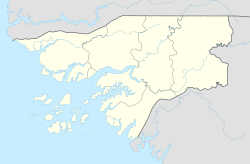Farim
This article includes a list of general references, but it lacks sufficient corresponding inline citations. (December 2016) |
Farim | |
|---|---|
 Ferry service at Farim | |
| Coordinates: 12°29′2″N 15°13′18″W / 12.48389°N 15.22167°W | |
| Country | Guinea-Bissau |
| Region | Oio Region |
| Founded | 1641 |
| Elevation | 2 m (7 ft) |
| Population (2009) | |
| • Total | 8,661 |
Farim is a town of northern Guinea-Bissau. It sits on the north bank of the Farim/Cacheu River, about 215 km (135 miles) up the river from Cacheu. Population 8,661 (2009 census).[1]
History
Farim was founded about 1641 by the Captain-Major of Cacheu, who recruited lançados from Geba to move to where they would be less vulnerable to attack by African tribes.[2] The name derived from farim, the title of the local Mandinka people's ruler. For their part, the Mandinkas and Soninke called the settlement Tubabodaga ("village of the whites").[3] It was well-situated as a port, since the river was continuously navigable by sailing vessels from Cacheu.
It became a presídio (garrisoned place) though an order dated 10 November 1696, in reaction to an anticipated attack from nearby Canico. The area remained generally peaceful, and the defenses gradually deteriorated. However, control of the surrounding region remained in the hands of the Buramo kings, and Portuguese control was limited to the fortress. In the late 17th century, the Buramo King of Farim held significant control over the Cacheu River, with the exception of several islands at the mouth of the river, ruled by independent principalities.[4]
It was a base for operations against Oio in 1897 and 1902. Farim started to grow in earnest in the 1910s, with over twenty trading firms based there, and became a vila (town) in 1918.
Farim had become a centro comercial by 1925, and experienced an influx of Lebanese and Syrian merchants, dealing in peanuts and timber. Its economy was hit hard by the independence struggle in the 1960s and 1970s.
Sports
There are several sports clubs (notably football and athletics) in Farim and area, including SC Farim.
Named after
A crater on Mars is named after the town.[5]
References
- ^ População por região, sector e localidades por sexo censo 2009 Archived 2020-03-31 at the Wayback Machine, Instituto Nacional de Estatística Guiné-Bissau
- ^ Rodney 1966, pp. 271.
- ^ Rodney 1966, pp. 157.
- ^ Crowley, Eve Lakshmi (1990). Contracts with the spirits: Religion, asylum, and ethnic identity in the Cacheu Region of Guinea-Bissau (Thesis).[page needed]
- ^ "Gazetteer of Planetary Nomenclature | Farim on Mars". usgs.gov. International Astronomical Union. Retrieved 2018-01-10.
Sources
- Richard Andrew Lobban Jr. and Peter Karibe Mendy, Historical Dictionary of the Republic of Guinea-Bissau, 3rd ed. (Scarecrow Press, 1997 ISBN 0-8108-3226-7) pp. 160–163
- Rodney, Walter Anthony (1966). A History of the Upper Guinea Coast, 1545–1800 (Thesis). doi:10.25501/SOAS.00031255.



